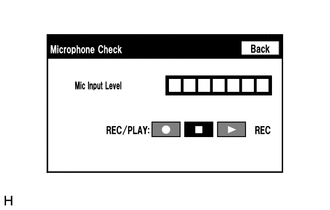Illumination Circuit
DESCRIPTION
Power is
supplied to the radio and display receiver assembly and steering pad
switch assembly illumination when the light control switch is in the
tail or head position.
WIRING DIAGRAM
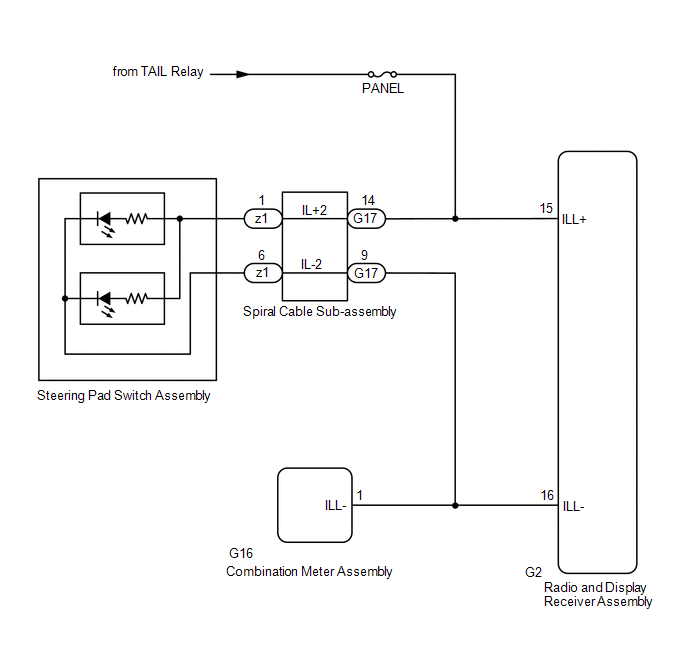
CAUTION / NOTICE / HINT
NOTICE:
- The vehicle is equipped with a Supplemental Restraint System (SRS) which
includes components such as airbags. Before servicing (including
removal or installation of parts), be sure to read the precaution for
Supplemental Restraint System.
Click here 
- Inspect the fuses for circuits related to this system before performing the following procedure.
PROCEDURE
(a)
Check if the illumination for the radio and display receiver assembly,
steering pad switch assembly, heater control switch or others (hazard
switch, transmission control switch, etc.) comes on when the light
control switch is turned to the head or tail position.
|
Result | Proceed to |
|
Illumination comes on for all components except steering pad switch assembly. |
A |
| Illumination comes on for all components except radio and display receiver assembly. |
B |
| No illumination comes on (radio and display receiver assembly, hazard switch, heater control switch, etc.). |
C |
| B |
 | GO TO STEP 5 |
| C |
 | GO TO LIGHTING SYSTEM |
|
A |
 | |
| 2. |
CHECK HARNESS AND CONNECTOR (ILLUMINATION SIGNAL) |
(a) Disconnect the G17 spiral cable sub-assembly connector.
(b) Measure the voltage according to the value(s) in the table below.
Standard Voltage:
|
Tester Connection | Condition |
Specified Condition |
|
G17-14 (IL+2) - Body ground |
Light control switch in tail or head position |
11 to 14 V |
| NG |
 | REPAIR OR REPLACE HARNESS OR CONNECTOR |
|
OK |
 | |
| 3. |
INSPECT STEERING PAD SWITCH ASSEMBLY |
(a) Remove the steering pad switch assembly.
Click here 
(b) Inspect the steering pad switch assembly.
Click here 
| NG |
 | REPLACE STEERING PAD SWITCH ASSEMBLY |
|
OK |
 | |
| 4. |
INSPECT SPIRAL CABLE SUB-ASSEMBLY |
(a) Remove the spiral cable sub-assembly.
Click here 
(b) Inspect the spiral cable sub-assembly.
Click here 
| OK |
 | REPAIR
OR REPLACE HARNESS OR CONNECTOR (SPIRAL CABLE SUB-ASSEMBLY - RADIO AND
DISPLAY RECEIVER ASSEMBLY, COMBINATION METER ASSEMBLY) |
| NG |
 | REPLACE SPIRAL CABLE SUB-ASSEMBLY |
| 5. |
CHECK HARNESS AND CONNECTOR (ILLUMINATION SIGNAL) |
(a) Disconnect the G2 radio and display receiver assembly connector.
(b) Measure the voltage according to the value(s) in the table below.
Standard Voltage:
|
Tester Connection | Condition |
Specified Condition |
|
G2-15 (ILL+) - Body ground |
Light control switch in tail or head position |
11 to 14 V |
| NG |
 | REPAIR OR REPLACE HARNESS OR CONNECTOR |
|
OK |
 | |
| 6. |
CHECK HARNESS AND CONNECTOR (RADIO AND DISPLAY RECEIVER ASSEMBLY - COMBINATION METER ASSEMBLY) |
(a) Disconnect the G2 radio and display receiver assembly connector.
(b) Disconnect the G16 combination meter assembly connector.
(c) Measure the resistance according to the value(s) in the table below.
Standard Resistance:
|
Tester Connection | Condition |
Specified Condition |
|
G2-16 (ILL-) - G16-1 (ILL-) |
Always | Below 1 Ω |
|
G2-16 (ILL-) or G16-1 (ILL-) - Body ground |
Always | 10 kΩ or higher |
| OK |
 | PROCEED TO NEXT SUSPECTED AREA SHOWN IN PROBLEM SYMPTOMS TABLE |
| NG |
 | REPAIR OR REPLACE HARNESS OR CONNECTOR |
Microphone Circuit
DESCRIPTION
- w/o Manual (SOS) Switch:
The radio and display receiver assembly, roof console
box sub-assembly and telephone microphone assembly are connected to each
other using the microphone connection detection signal lines.
Using
this circuit, the radio and display receiver assembly sends power to
the roof console box sub-assembly and telephone microphone assembly, and
the roof console box sub-assembly and telephone microphone assembly
sends microphone signals to the radio and display receiver assembly.
- w/ Manual (SOS) Switch:
The radio and display receiver assembly, roof console
box sub-assembly and telephone microphone assembly are connected to each
other using the microphone connection detection signal lines.
Using
this circuit, the DCM (telematics transceiver) sends power to the roof
console box sub-assembly and telephone microphone assembly, and the roof
console box sub-assembly and telephone microphone assembly sends
microphone signals to the radio and display receiver assembly via the
DCM (telematics transceiver).
WIRING DIAGRAM
w/o Manual (SOS) Switch
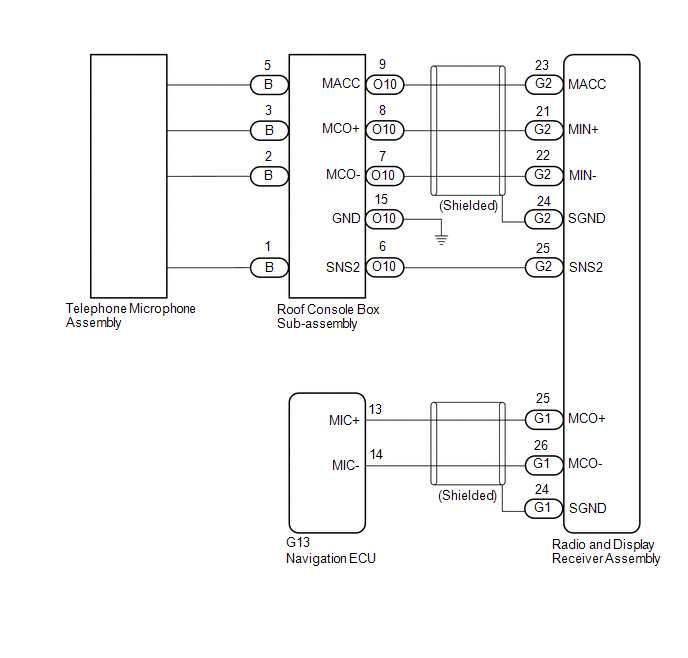 w/ Manual (SOS) Switch
w/ Manual (SOS) Switch
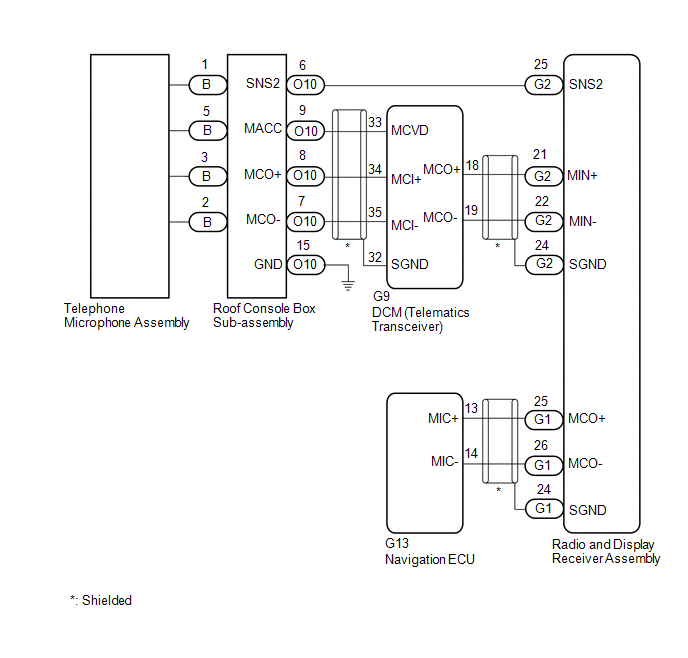
CAUTION / NOTICE / HINT
NOTICE:
- Depending on the parts that are replaced during vehicle inspection or
maintenance, performing initialization, registration or calibration may
be needed. Refer to Precaution for Navigation System.
Click here 
- When replacing the radio and display receiver assembly, always replace
it with a new one. If a radio and display receiver assembly which was
installed to another vehicle is used, the following may occur:
- A communication malfunction DTC may be stored.
- The radio and display receiver assembly may not operate normally.
- Before replacing the DCM (telematics transceiver), refer to Registration.
Click here 
PROCEDURE
|
1. | CHECK MICROPHONE AND VOICE RECOGNITION (INPUT TO NAVIGATION ECU) |
| (a) Enter the "Microphone Check" screen. Refer to Check Microphone (Input to navigation ECU) in Operation Check.
Click here  | |
(b) When voice is input into the microphone, check that the microphone input level meter changes according to the input voice.
OK:
Check result is normal.
| OK |
 | PROCEED TO NEXT SUSPECTED AREA SHOWN IN PROBLEM SYMPTOMS TABLE |
|
NG |
 | |
| 2. |
CHECK MICROPHONE AND VOICE RECOGNITION (INPUT TO RADIO AND DISPLAY RECEIVER ASSEMBLY) |
| (a)
Enter the "Microphone Check" screen. Refer to Check Microphone (Input
to radio and display receiver assembly) in Operation Check. Click here
 | |
(b) When voice is input into the microphone, check that the microphone input level meter changes according to the input voice.
OK:
Check result is normal.
|
Result | Proceed to |
|
NG (w/o Manual (SOS) Switch) |
A |
| NG (w/ Manual (SOS) Switch) |
B |
| OK |
C |
| B |
 | GO TO STEP 9 |
| C |
 | GO TO STEP 19 |
|
A |
 | |
| 3. |
CHECK HARNESS AND CONNECTOR (RADIO AND DISPLAY RECEIVER ASSEMBLY - ROOF CONSOLE BOX SUB-ASSEMBLY) |
(a) Disconnect the G2 radio and display receiver assembly connector.
(b) Disconnect the O10 roof console box sub-assembly connector.
(c) Measure the resistance according to the value(s) in the table below.
Standard Resistance:
|
Tester Connection | Condition |
Specified Condition |
|
G2-25 (SNS2) - O10-6 (SNS2) |
Always | Below 1 Ω |
|
G2-23 (MACC) - O10-9 (MACC) |
Always | Below 1 Ω |
|
G2-21 (MIN+) - O10-8 (MCO+) |
Always | Below 1 Ω |
|
G2-22 (MIN-) - O10-7 (MCO-) |
Always | Below 1 Ω |
|
G2-25 (SNS2) or O10-6 (SNS2) - Body ground |
Always | 10 kΩ or higher |
|
G2-23 (MACC) or O10-9 (MACC) - Body ground |
Always | 10 kΩ or higher |
|
G2-21 (MIN+) or O10-8 (MCO+) - Body ground |
Always | 10 kΩ or higher |
|
G2-22 (MIN-) or O10-7 (MCO-) - Body ground |
Always | 10 kΩ or higher |
|
G2-24 (SGND) - Body ground |
Always | 10 kΩ or higher |
| NG |
 | REPAIR OR REPLACE HARNESS OR CONNECTOR |
|
OK |
 | |
| 4. |
INSPECT RADIO AND DISPLAY RECEIVER ASSEMBLY |
(a) Connect the G2 radio and display receiver assembly connector.
(b) Connect the O10 roof console box sub-assembly connector.
| (c) Measure the voltage according to the value(s) in the table below.
Standard Voltage: |
Tester Connection | Condition |
Specified Condition | |
G2-23 (MACC) - Body ground |
Engine switch on (ACC) |
4 to 6 V | |
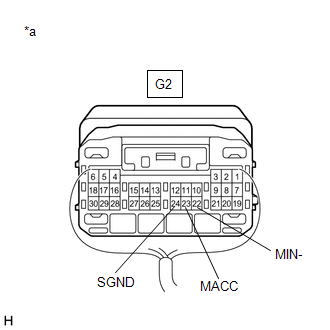 |
|
*a | Component with harness connected (Radio and Display Receiver Assembly) | | |
(d) Measure the resistance according to the value(s) in the table below.
Standard Resistance:
|
Tester Connection | Condition |
Specified Condition |
|
G2-24 (SGND) - Body ground |
Always | Below 1 Ω |
|
G2-22 (MIN-) - Body ground |
Always | Below 1 Ω |
| NG |
 | REPLACE RADIO AND DISPLAY RECEIVER ASSEMBLY |
|
OK |
 | |
| 5. |
INSPECT ROOF CONSOLE BOX SUB-ASSEMBLY |
(a) Remove the roof console box sub-assembly.
Click here

(b) Connect the B telephone microphone assembly connector.
| (c) Measure the resistance according to the value(s) in the table below.
Standard Resistance: |
Tester Connection | Condition |
Specified Condition | |
6 (SNS2) - 7 (MCO-) |
Always | Below 1 Ω | |
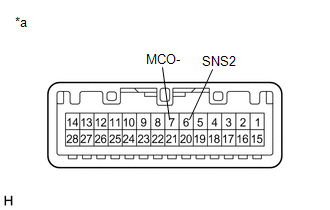 |
|
*a | Component without harness connected
(Roof Console Box Sub-assembly) | | |
| NG |
 | GO TO STEP 8 |
|
OK |
 | |
| 6. |
INSPECT ROOF CONSOLE BOX SUB-ASSEMBLY (OUTPUT TO RADIO AND DISPLAY RECEIVER ASSEMBLY) |
(a) Connect the G2 radio and display receiver assembly connector.
(b) Connect the O10 roof console box sub-assembly connector.
(c) Turn the engine switch on (ACC).
| (d) Connect an oscilloscope to terminals 8 (MCO+) and 7 (MCO-) of the O10 roof console box sub-assembly connector. |
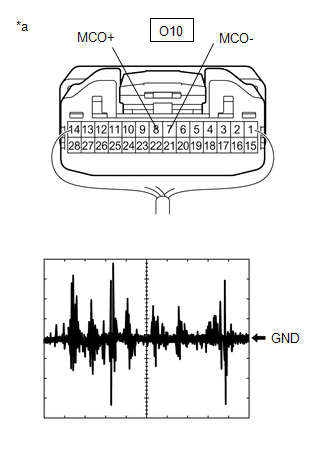 |
|
*a | Component with harness connected
(Roof Console Box Sub-assembly) | | |
(e) Check the signal waveform according to the condition(s) in the table below.
|
Item | Condition |
|
Measurement terminal |
O10-8 (MCO+) - O10-7 (MCO-) |
|
Tool setting | 50 mV/DIV., 500 ms/DIV. |
|
Vehicle condition |
- Turn the engine switch on (ACC).
- Sound is input to the roof console box sub-assembly when the user is
closer than 125 mm from the roof console box sub-assembly sound holes.
|
OK:
The waveform is similar to that shown in the illustration.
HINT:
The oscilloscope waveform shown in the illustration is an example for reference only.
| OK |
 | PROCEED TO NEXT SUSPECTED AREA SHOWN IN PROBLEM SYMPTOMS TABLE |
|
NG |
 | |
| 7. |
INSPECT ROOF CONSOLE BOX SUB-ASSEMBLY |
(a) Remove the roof console box sub-assembly.
Click here

(b) Disconnect the B telephone microphone assembly connector.
| (c) Measure the resistance according to the value(s) in the table below.
Standard Resistance: |
Tester Connection | Condition |
Specified Condition | |
O10-8 (MCO+) - B-3 |
Always | Below 1 Ω | |
O10-7 (MCO-) - B-2 |
Always | Below 1 Ω | |
O10-8 (MCO+) or B-3 - O10-15 (GND) |
Always | 10 kΩ or higher | |
O10-7 (MCO-) or B-2 - O10-15 (GND) |
Always | 10 kΩ or higher | |
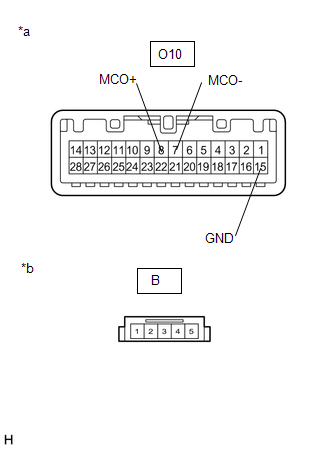 |
|
*a | Component without harness connected
(Roof Console Box Sub-assembly (No. 1 Roof Wire Side)) | |
*b | Component without harness connected
(Roof Console Box Sub-assembly (Telephone Microphone Assembly Side)) | | |
| OK |
 | REPLACE TELEPHONE MICROPHONE ASSEMBLY |
| NG |
 | REPLACE ROOF CONSOLE BOX SUB-ASSEMBLY |
| 8. |
INSPECT ROOF CONSOLE BOX SUB-ASSEMBLY |
(a) Remove the roof console box sub-assembly.
Click here

(b) Disconnect the B telephone microphone assembly connector.
| (c) Measure the resistance according to the value(s) in the table below.
Standard Resistance: |
Tester Connection | Condition |
Specified Condition | |
O10-6 (SNS2) - B-1 |
Always | Below 1 Ω | |
O10-7 (MCO-) - B-2 |
Always | Below 1 Ω | |
O10-6 (SNS2) or B-1 - O10-15 (GND) |
Always | 10 kΩ or higher | |
O10-7 (MCO-) or B-2 - O10-15 (GND) |
Always | 10 kΩ or higher | |
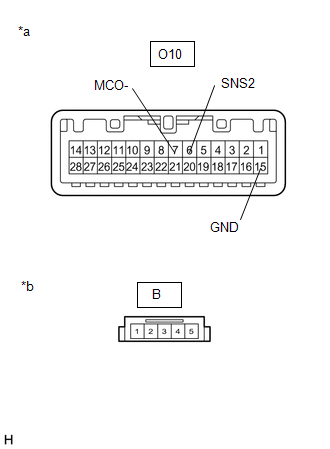 |
|
*a | Component without harness connected
(Roof Console Box Sub-assembly (No. 1 Roof Wire Side)) | |
*b | Component without harness connected
(Roof Console Box Sub-assembly (Telephone Microphone Assembly Side)) | | |
| OK |
 | REPLACE TELEPHONE MICROPHONE ASSEMBLY |
| NG |
 | REPLACE ROOF CONSOLE BOX SUB-ASSEMBLY |
| 9. |
CHECK HARNESS AND CONNECTOR (RADIO AND DISPLAY RECEIVER ASSEMBLY - ROOF CONSOLE BOX SUB-ASSEMBLY) |
(a) Disconnect the G2 radio and display receiver assembly connector.
(b) Disconnect the O10 roof console box sub-assembly connector.
(c) Measure the resistance according to the value(s) in the table below.
Standard Resistance:
|
Tester Connection | Condition |
Specified Condition |
|
G2-25 (SNS2) - O10-6 (SNS2) |
Always | Below 1 Ω |
|
G2-25 (SNS2) or O10-6 (SNS2) - Body ground |
Always | 10 kΩ or higher |
| NG |
 | REPAIR OR REPLACE HARNESS OR CONNECTOR |
|
OK |
 | |
| 10. |
CHECK HARNESS AND CONNECTOR (RADIO AND DISPLAY RECEIVER ASSEMBLY - DCM (TELEMATICS TRANSCEIVER)) |
(a) Disconnect the G2 radio and display receiver assembly connector.
(b) Disconnect the G9 DCM (telematics transceiver) connector.
(c) Measure the resistance according to the value(s) in the table below.
Standard Resistance:
|
Tester Connection | Condition |
Specified Condition |
|
G2-21 (MIN+) - G9-18 (MCO+) |
Always | Below 1 Ω |
|
G2-22 (MIN-) - G9-19 (MCO-) |
Always | Below 1 Ω |
|
G2-21 (MIN+) or G9-18 (MCO+) - Body ground |
Always | 10 kΩ or higher |
|
G2-22 (MIN-) or G9-19 (MCO-) - Body ground |
Always | 10 kΩ or higher |
|
G2-24 (SGND) - Body ground |
Always | 10 kΩ or higher |
| NG |
 | REPAIR OR REPLACE HARNESS OR CONNECTOR |
|
OK |
 | |
| 11. |
CHECK HARNESS AND CONNECTOR (DCM (TELEMATICS TRANSCEIVER) - ROOF CONSOLE BOX SUB-ASSEMBLY) |
(a) Disconnect the G9 DCM (telematics transceiver) connector.
(b) Disconnect the O10 roof console box sub-assembly connector.
(c) Measure the resistance according to the value(s) in the table below.
Standard Resistance:
|
Tester Connection | Condition |
Specified Condition |
|
G9-33 (MCVD) - O10-9 (MACC) |
Always | Below 1 Ω |
|
G9-34 (MCI+) - O10-8 (MCO+) |
Always | Below 1 Ω |
|
G9-35 (MCI-) - O10-7 (MCO-) |
Always | Below 1 Ω |
|
G9-33 (MCVD) or O10-9 (MACC) - Body ground |
Always | 10 kΩ or higher |
|
G9-34 (MCI+) or O10-8 (MCO+) - Body ground |
Always | 10 kΩ or higher |
|
G9-35 (MCI-) or O10-7 (MCO-) - Body ground |
Always | 10 kΩ or higher |
|
G9-32 (SGND) - Body ground |
Always | 10 kΩ or higher |
| NG |
 | REPAIR OR REPLACE HARNESS OR CONNECTOR |
|
OK |
 | |
| 12. |
INSPECT RADIO AND DISPLAY RECEIVER ASSEMBLY |
(a) Disconnect the G9 DCM (telematics transceiver) connector.
| (b) Connect the G2 radio and display receiver assembly connector. |
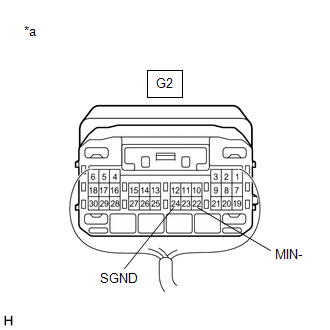 |
|
*a | Component with harness connected (Radio and Display Receiver Assembly) | | |
(c) Measure the resistance according to the value(s) in the table below.
Standard Resistance:
|
Tester Connection | Condition |
Specified Condition |
|
G2-24 (SGND) - Body ground |
Always | Below 1 Ω |
|
G2-22 (MIN-) - Body ground |
Always | Below 1 Ω |
| NG |
 | REPLACE RADIO AND DISPLAY RECEIVER ASSEMBLY |
|
OK |
 | |
| 13. |
INSPECT DCM (TELEMATICS TRANSCEIVER) |
(a) Connect the G9 DCM (telematics transceiver) connector.
| (b) Measure the voltage according to the value(s) in the table below.
Standard Voltage: |
Tester Connection | Condition |
Specified Condition | |
G9-33 (MCVD) - Body ground |
Engine switch on (ACC) |
4 to 6 V | |
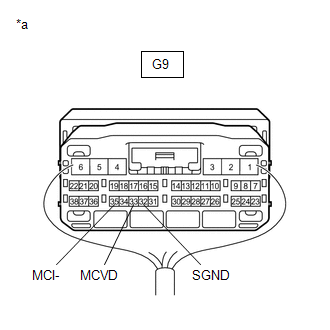 |
|
*a | Component with harness connected (DCM (Telematics Transceiver)) | | |
(c) Measure the resistance according to the value(s) in the table below.
Standard Resistance:
|
Tester Connection | Condition |
Specified Condition |
|
G9-35 (MCI-) - Body ground |
Always | Below 1 Ω |
|
G9-32 (SGND) - Body ground |
Always | Below 1 Ω |
| NG |
 | REPLACE DCM (TELEMATICS TRANSCEIVER) |
|
OK |
 | |
| 14. |
INSPECT ROOF CONSOLE BOX SUB-ASSEMBLY |
(a) Remove the roof console box sub-assembly.
Click here

(b) Connect the B telephone microphone assembly connector.
| (c) Measure the resistance according to the value(s) in the table below.
Standard Resistance: |
Tester Connection | Condition |
Specified Condition | |
6 (SNS2) - 7 (MCO-) |
Always | Below 1 Ω | |
 |
|
*a | Component without harness connected
(Roof Console Box Sub-assembly) | | |
| NG |
 | GO TO STEP 18 |
|
OK |
 | |
| 15. |
INSPECT ROOF CONSOLE BOX SUB-ASSEMBLY (OUTPUT TO DCM (TELEMATICS TRANSCEIVER)) |
(a) Connect the G2 radio and display receiver assembly connector.
(b) Connect the O10 roof console box sub-assembly connector.
(c) Connect the G9 DCM (telematics transceiver) connector.
(d) Turn the engine switch on (ACC).
| (e) Connect an oscilloscope to terminals 8 (MCO+) and 7 (MCO-) of the O10 roof console box sub-assembly connector. |
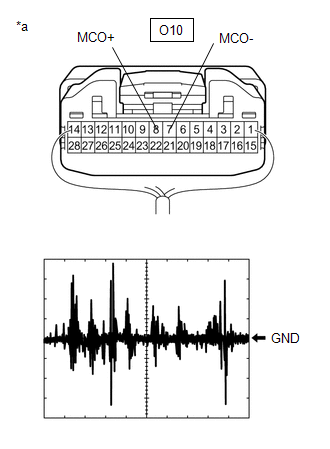 |
|
*a | Component with harness connected
(Roof Console Box Sub-assembly) | | |
(f) Check the signal waveform according to the condition(s) in the table below.
|
Item | Condition |
|
Measurement terminal |
O10-8 (MCO+) - O10-7 (MCO-) |
|
Tool setting | 50 mV/DIV., 500 ms/DIV. |
|
Vehicle condition |
- Turn the engine switch on (ACC).
- Sound is input to the roof console box sub-assembly when the user is
closer than 125 mm from the roof console box sub-assembly sound holes.
|
OK:
The waveform is similar to that shown in the illustration.
HINT:
The oscilloscope waveform shown in the illustration is an example for reference only.
| NG |
 | GO TO STEP 17 |
|
OK |
 | |
| 16. |
INSPECT DCM (TELEMATICS TRANSCEIVER) (OUTPUT TO RADIO AND DISPLAY RECEIVER ASSEMBLY) |
(a) Connect the G2 radio and display receiver assembly connector.
(b) Connect the O10 roof console box sub-assembly connector.
(c) Connect the G9 DCM (telematics transceiver) connector.
(d) Turn the engine switch on (ACC).
| (e) Connect an oscilloscope to terminals 18 (MCO+) and 19 (MCO-) of the G9 DCM (telematics transceiver) connector. |
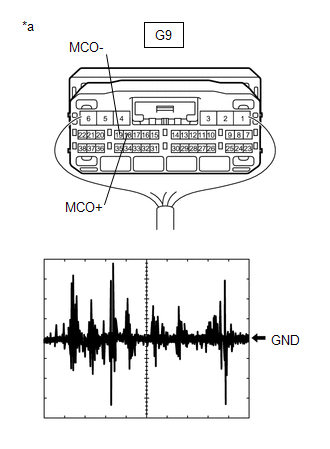 |
|
*a | Component with harness connected
DCM (Telematics Transceiver) | | |
(f) Check the signal waveform according to the condition(s) in the table below.
|
Item | Condition |
|
Measurement terminal |
G9-18 (MCO+) - G9-19 (MCO-) |
|
Tool setting | 50 mV/DIV., 500 ms/DIV. |
|
Vehicle condition |
- Turn the engine switch on (ACC).
- Sound is input to the roof console box sub-assembly when the user is
closer than 125 mm from the roof console box sub-assembly sound holes.
|
OK:
The waveform is similar to that shown in the illustration.
HINT:
The oscilloscope waveform shown in the illustration is an example for reference only.
| OK |
 | PROCEED TO NEXT SUSPECTED AREA SHOWN IN PROBLEM SYMPTOMS TABLE |
| NG |
 | REPLACE DCM (TELEMATICS TRANSCEIVER) |
| 17. |
INSPECT ROOF CONSOLE BOX SUB-ASSEMBLY |
(a) Remove the roof console box sub-assembly.
Click here

(b) Disconnect the B telephone microphone assembly connector.
| (c) Measure the resistance according to the value(s) in the table below.
Standard Resistance: |
Tester Connection | Condition |
Specified Condition | |
O10-8 (MCO+) - B-3 |
Always | Below 1 Ω | |
O10-7 (MCO-) - B-2 |
Always | Below 1 Ω | |
O10-8 (MCO+) or B-3 - O10-15 (GND) |
Always | 10 kΩ or higher | |
O10-7 (MCO-) or B-2 - O10-15 (GND) |
Always | 10 kΩ or higher | |
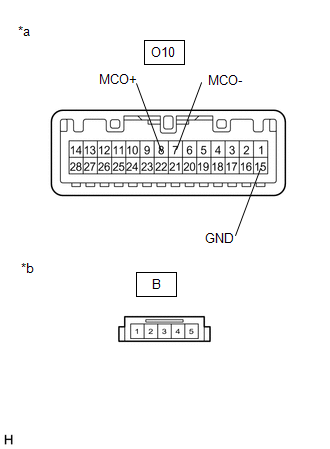 |
|
*a | Component without harness connected
(Roof Console Box Sub-assembly (No. 1 Roof Wire Side)) | |
*b | Component without harness connected
(Roof Console Box Sub-assembly (Telephone Microphone Assembly Side)) | | |
| OK |
 | REPLACE TELEPHONE MICROPHONE ASSEMBLY |
| NG |
 | REPLACE ROOF CONSOLE BOX SUB-ASSEMBLY |
| 18. |
INSPECT ROOF CONSOLE BOX SUB-ASSEMBLY |
(a) Remove the roof console box sub-assembly.
Click here

(b) Disconnect the B telephone microphone assembly connector.
| (c) Measure the resistance according to the value(s) in the table below.
Standard Resistance: |
Tester Connection | Condition |
Specified Condition | |
O10-6 (SNS2) - B-1 |
Always | Below 1 Ω | |
O10-7 (MCO-) - B-2 |
Always | Below 1 Ω | |
O10-6 (SNS2) or B-1 - O10-15 (GND) |
Always | 10 kΩ or higher | |
O10-7 (MCO-) or B-2 - O10-15 (GND) |
Always | 10 kΩ or higher | |
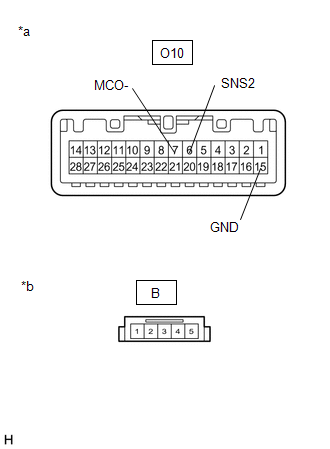 |
|
*a | Component without harness connected
(Roof Console Box Sub-assembly (No. 1 Roof Wire Side)) | |
*b | Component without harness connected
(Roof Console Box Sub-assembly (Telephone Microphone Assembly Side)) | | |
| OK |
 | REPLACE TELEPHONE MICROPHONE ASSEMBLY |
| NG |
 | REPLACE ROOF CONSOLE BOX SUB-ASSEMBLY |
| 19. |
CHECK HARNESS AND CONNECTOR (RADIO AND DISPLAY RECEIVER ASSEMBLY - NAVIGATION ECU) |
(a) Disconnect the G1 radio and display receiver assembly connector.
(b) Disconnect the G13 navigation ECU connector.
(c) Measure the resistance according to the value(s) in the table below.
Standard Resistance:
|
Tester Connection | Condition |
Specified Condition |
|
G1-25 (MCO+) - G13-13 (MIC+) |
Always | Below 1 Ω |
|
G1-26 (MCO-) - G13-14 (MIC-) |
Always | Below 1 Ω |
|
G1-25 (MCO+) or G13-13 (MIC+) - Body ground |
Always | 10 kΩ or higher |
|
G1-26 (MCO-) or G13-14 (MIC-) - Body ground |
Always | 10 kΩ or higher |
|
G1-24 (SGND) - Body ground |
Always | 10 kΩ or higher |
| NG |
 | REPAIR OR REPLACE HARNESS OR CONNECTOR |
|
OK |
 | |
| 20. |
INSPECT RADIO AND DISPLAY RECEIVER ASSEMBLY (OUTPUT TO NAVIGATION ECU) |
(a) Disconnect the G13 navigation ECU connector.
(b) Turn the engine switch on (ACC).
| (c) Check the signal waveform according to the condition(s) in the table below. |
Item | Condition | |
Measurement terminal |
G13-13 (MIC+) - G13-14 (MIC-) | |
Tool setting | 50 mV/DIV., 500 ms/DIV. | |
Vehicle condition |
- Turn the engine switch on (ACC).
- Sound is input to the roof console box sub-assembly when the user is
closer than 125 mm from the roof console box sub-assembly sound holes.
| OK: The waveform is similar to that shown in the illustration.
HINT: The oscilloscope waveform shown in the illustration is an example for reference only. |
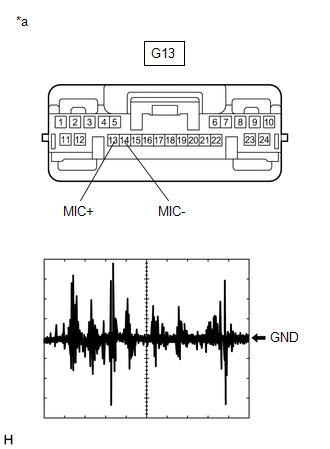 |
|
*a | Front view of wire harness connector
(to Navigation ECU) | | |
| OK |
 | PROCEED TO NEXT SUSPECTED AREA SHOWN IN PROBLEM SYMPTOMS TABLE |
| NG |
 | REPLACE RADIO AND DISPLAY RECEIVER ASSEMBLY |





















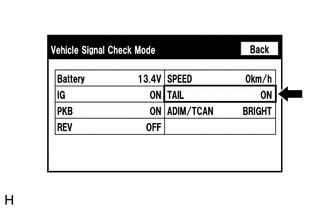


 w/ Manual (SOS) Switch
w/ Manual (SOS) Switch




